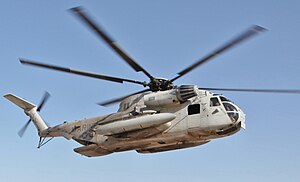| CH-53 Sea Stallion | |
|---|---|
 | |
| General information | |
| Type | Heavy-lift cargo helicopter |
| National origin | United States |
| Manufacturer | Sikorsky Aircraft |
| Status | In service |
| Primary users | United States Marine Corps (historical) |
| History | |
| Manufactured | 1964–1978 |
| Introduction date | 1966 |
| First flight | YCH-53: 14 October 1964 |
| Retired | 2012 (USMC)[1] |
| Variants | HH-53 "Super Jolly Green Giant"/MH-53 Pave Low |
| Developed into | Sikorsky CH-53E Super Stallion |
The CH-53 Sea Stallion (Sikorsky S-65) is an American family of heavy-lift transport helicopters designed and built by the American manufacturer Sikorsky Aircraft. The Sea Stallion was originally developed in response to a request from the United States Navy's Bureau of Naval Weapons made in March 1962 for a replacement for the Sikorsky CH-37 Mojave helicopters flown by the United States Marine Corps (USMC).
In July 1962, Sikorsky's proposal, which was essentially a scaled-up S-61R fitted with twin General Electric T64 turboshaft engines and the dynamic system of the S-64/CH-54, was selected. On 14 October 1964, the YCH-53A performed its maiden flight; the first deliveries of production CH-53s to operational units commenced on 12 September 1966. The first combat use of the type occurred during the following year when it was deployed to the Vietnamese theater; the CH-53 quickly proved its value for moving heavy payloads, particularly in the recovery of damaged aircraft.
Several variants of the type were promptly introduced. The United States Air Force introduced the HH-53 "Super Jolly Green Giant", configured for special operations and combat search and rescue (CSAR) missions, during the latter part of the Vietnam War; the majority of these were subsequently rebuilt into the MH-53 Pave Low. The visually similar CH-53E Super Stallion is a heavier-lifting improved version of the rotorcraft, designated S-80E by Sikorsky; its third engine makes it more powerful than the Sea Stallion and thus displaced it for the heavy-lift mission. Furthermore, many early-build CH-53s were refitted with more powerful engines, while others were reconfigured for different mission roles, such as US presidential flights, training, and airborne mine countermeasures (AMCM) operations.
Several export deals for the CH-53 were made, leading to several international operators of the type. Among these are Germany, Iran, and Israel. Several unusual or high-profile operations have been undertaken, such as the capture and transportation of a Soviet advanced radar system to Israel under Operation Rooster 53 in 1969, and Iran's capture of five American CH-53s as a result of Operation Eagle Claw in 1980. Various operators deployed their CH-53s during international missions, often under the auspices of NATO or the United Nations, such as for UNSCOM in Iraq, in Kosovo with KFOR, IFOR in Bosnia and Herzegovina, and the ISAF in Afghanistan. While several operators have opted to retain the type into the twenty-first century, many others have opted to supplement or withdraw their Sea Stallions in favor of other platforms, sometimes with the more powerful CH-53E. The CH-53 remains in service with German and Israeli forces, and is one of the largest military helicopters in service. Germany is planning to replace its fleet, as of the 2020s, with the latest version of the twin-rotor CH-47 Chinook. The latest version of the CH-53, the K model King Stallion is in production as of the 2020s entering service with the United States Marine Corps; this is replacing the Super Stallion, itself an upgraded version of Sea Stallion. The heavily upgraded Jolly Green Giant and Pave Low versions of the CH-53 were retired by 2008, flown by the U.S. Air Force for combat search and rescue. Overall, the CH-53 was replaced in many roles by the V-22 tilt rotor in U.S. service.
- ^ "End of an Era for an Icon of Marine Aviation". aero-news.net. 12 August 2012. Retrieved 15 April 2013.